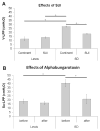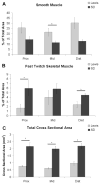Strain-dependent urethral response
- PMID: 21826722
- PMCID: PMC4307400
- DOI: 10.1002/nau.21158
Strain-dependent urethral response
Abstract
Aims: The Sprague-Dawley (SD) rat, an out-bred, all-purpose strain, has served well for lower urinary tract research. However, to test new cellular therapies for conditions such as stress urinary incontinence, an in-bred rat strain with immune tolerance, such as the Lewis rat, may be more useful. The objective of this study was to reveal any differences in lower urinary tract continence mechanisms between the Lewis and SD rat.
Methods: The contribution of (1) the striated and smooth muscle to the mechanical and functional properties of the urethra in vitro, and (2) the striated sphincter to leak point pressure (LPP) and reflex continence mechanisms in vivo were assessed in normal (control) Lewis and SD rats and in a model of stress urinary incontinence produced by bilateral pudendal nerve transection.
Results: Control, Lewis rats had significantly lower LPP, significantly less fast-twitch skeletal muscle and relied less on the striated sphincter for continence than control, SD rats, as indicated by the failure of neuromuscular blockade with alpha-bungarotoxin to reduce LPP. Nerve transection significantly decreased LPP in the SD rat, but not in the Lewis rat. Although the Lewis urethra contained more smooth muscle than the SD rat, it was less active in vitro as indicated by a low urethral baseline pressure and lack of response to phenylephrine.
Conclusions: We have observed distinct differences in functional and mechanical properties of the SD and Lewis urethra and have shown that the Lewis rat may not be suitable as a chronic model of SUI via nerve transection.
Copyright © 2011 Wiley Periodicals, Inc.
Conflict of interest statement
Conflict of interest: none.
Figures





References
-
- Nygaard IE, Heit M. Stress urinary incontinence. Obstet Gynecol. 2004;104:607–20. - PubMed
-
- Tsui KP, Ng SC, Tee YT, et al. Complications of synthetic graft materials used in suburethral sling procedures. Int Urogynecol J Pelvic Floor Dysfunct. 2005;16:165–7. - PubMed
-
- Aboushwareb T, Atala A. Stem cells in urology. Nat Clin Pract Urol. 2008;5:621–31. - PubMed
-
- Cannon TW, Lee JY, Somogyi G, et al. Improved sphincter contractility after allogenic muscle-derived progenitor cell injection into the denervated rat urethra. Urology. 2003;62:958–63. - PubMed
-
- Lee JY, Cannon TW, Pruchnic R, et al. The effects of periurethral muscle-derived stem cell injection on leak point pressure in a rat model of stress urinary incontinence. Int Urogynecol J Pelvic Floor Dysfunct. 2003;14:31–7. discussion 7. - PubMed
Publication types
MeSH terms
Substances
Grants and funding
LinkOut - more resources
Full Text Sources
Medical

